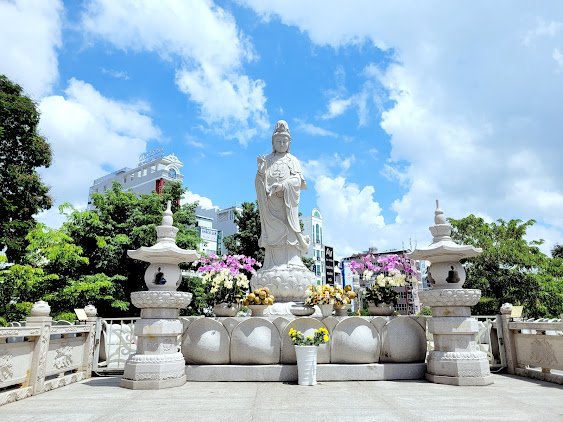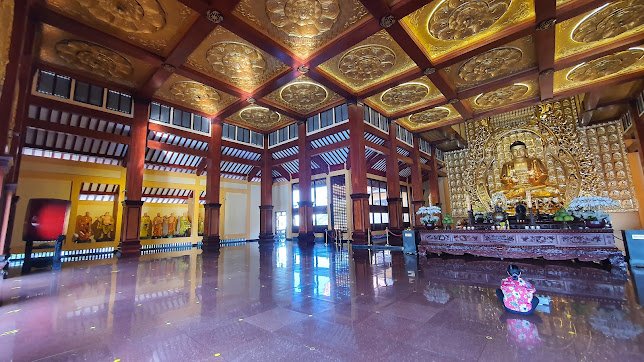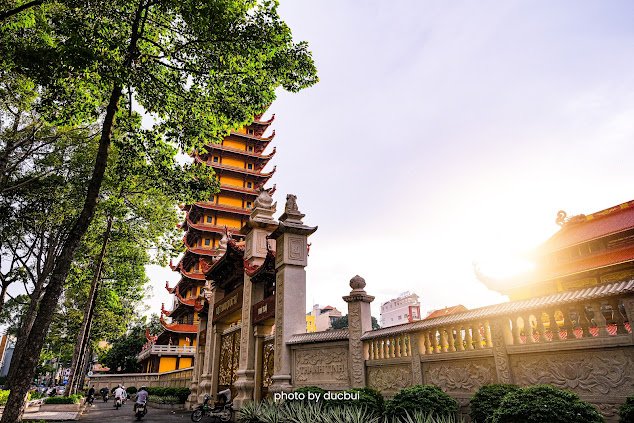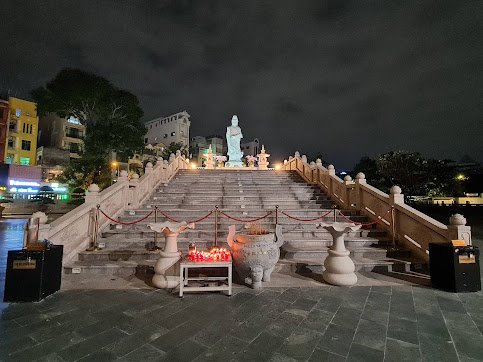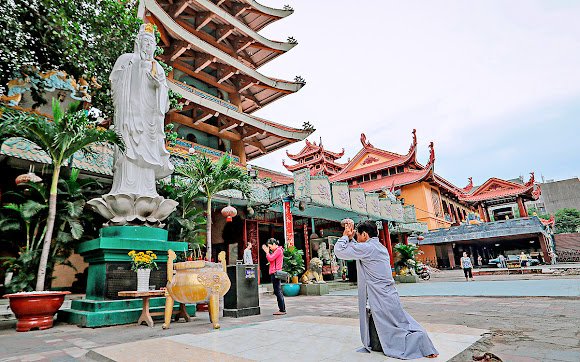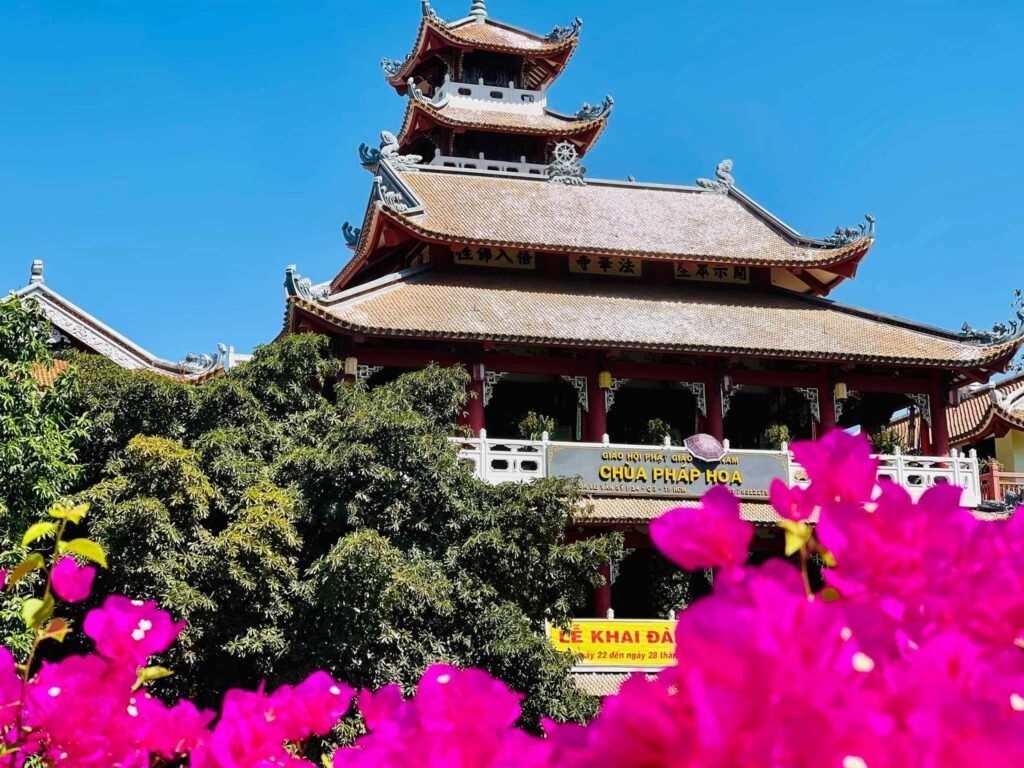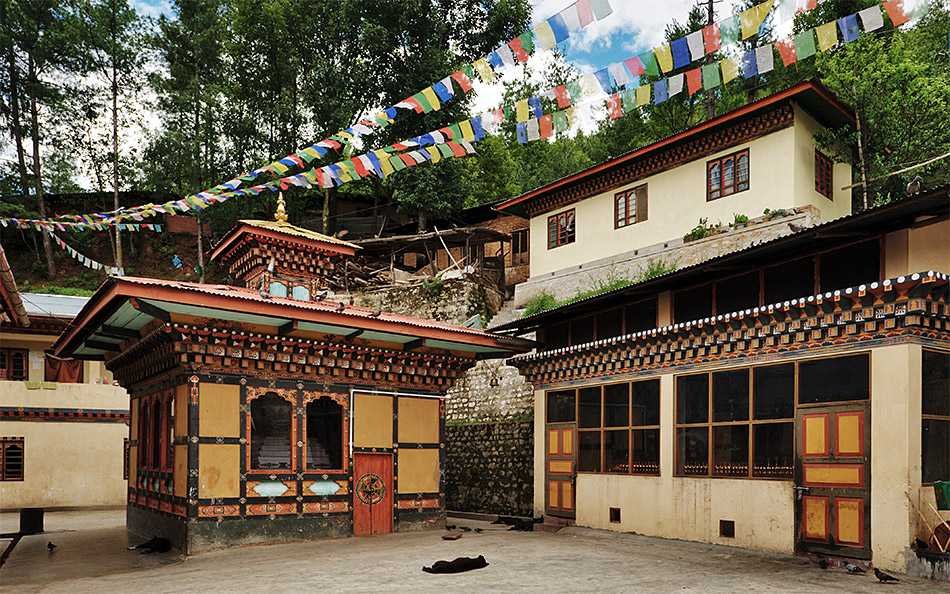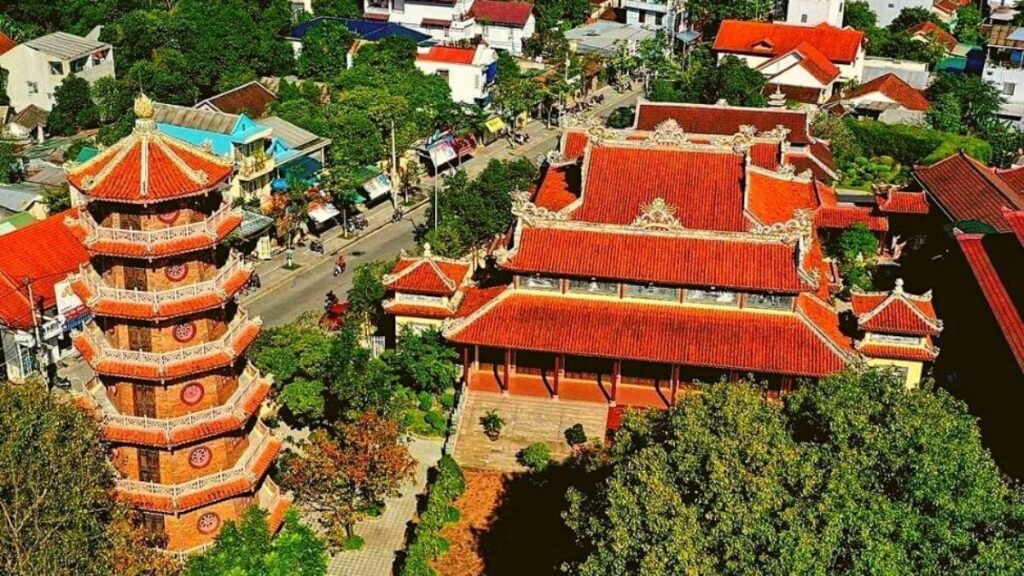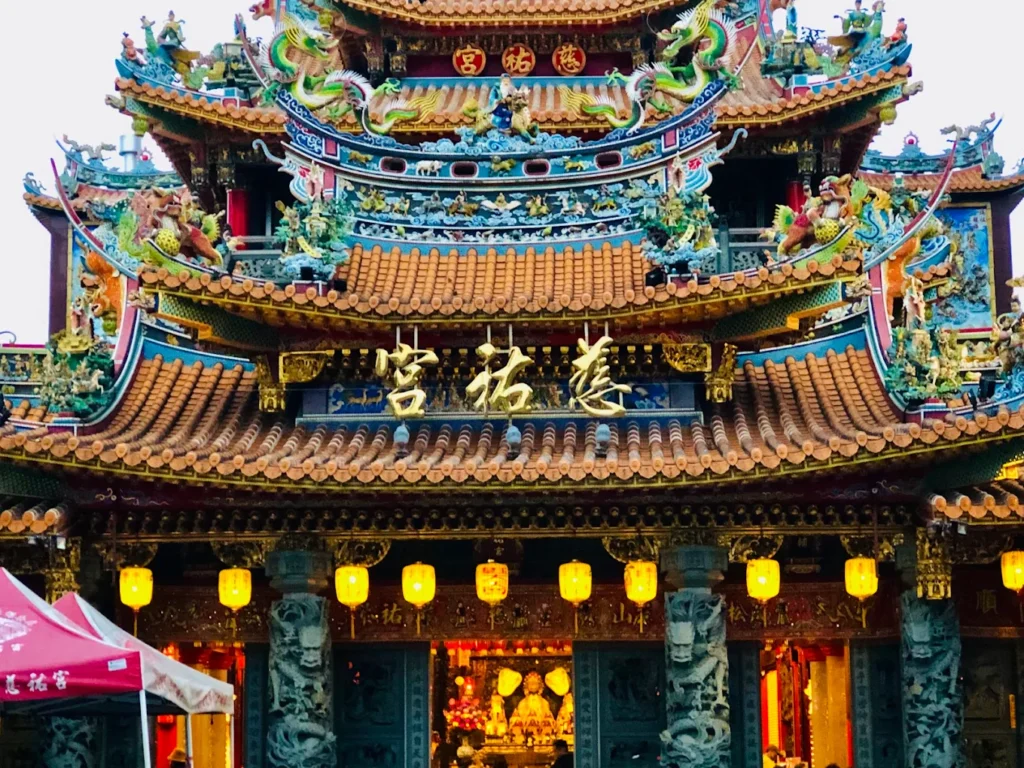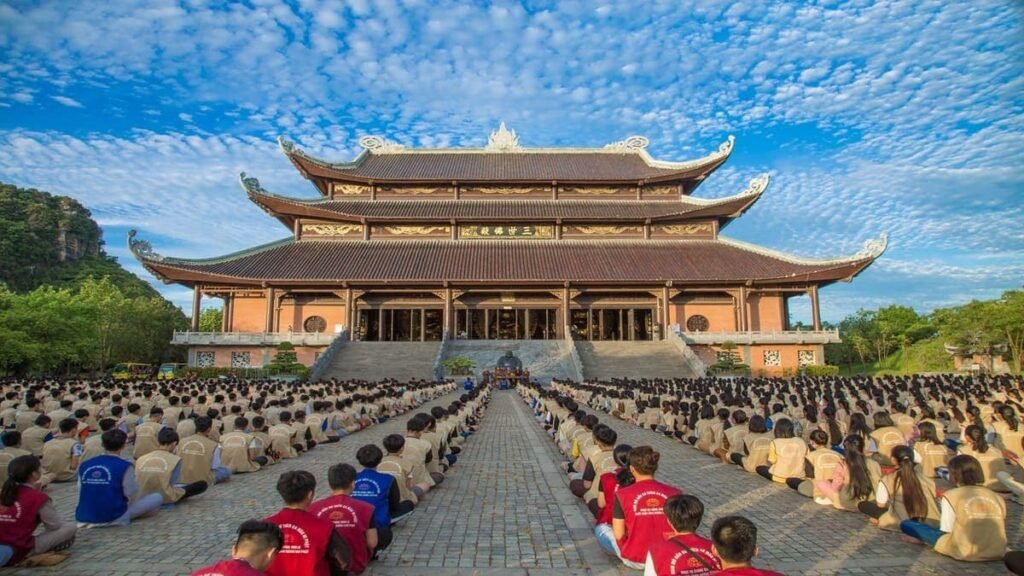Việt Nam Quốc Tự Pagoda: The Majestic National Pagoda
As dusk drapes Ho Chi Minh City’s District 10, Việt Nam Quốc Tự awakens on Ba Tháng Hai Street, its 13-story stupa casting an amber sheen across the evening air. Sandalwood incense swirls through the main hall, where a 7.5-meter bronze statue of Shakyamuni Buddha (Phật Thích Ca Mâu Ni), the enlightened founder, sits in meditative repose, joined by Avalokiteshvara (Bồ Tát Quán Thế Âm), her compassionate form etched in soft bronze. During the Vesak Festival (Lễ Phật Đản), lotus-shaped lanterns sway in the courtyard, their glow pulsing with the chants of devotees honoring Buddha’s life. Founded in 1963 by Hòa thượng Thích Tâm Giác, this Northern Mahayana (Bắc Tông) sanctuary, rooted in compassion and communal enlightenment, stands as a monument to the Buddhist protest that stirred Vietnam. Amid the city’s restless rhythm, it offers a space where faith and resilience intertwine, beckoning seekers to its quiet embrace.
Overview and Significance
Việt Nam Quốc Tự rises in Ho Chi Minh City’s District 10, a cornerstone of Northern Mahayana Buddhism, its 13-story stupa a testament to spiritual resolve and historical defiance. This sanctuary weaves a story of protest, renewal, and devotion, drawing pilgrims and travelers into Vietnam’s Buddhist heritage.
Introduction to Việt Nam Quốc Tự
Việt Nam Quốc Tự, the National Pagoda, stands as a vibrant symbol of Northern Mahayana Buddhism in Ho Chi Minh City, its yellow walls and red-tiled roofs blending tradition with modern scale. Northern Mahayana emphasizes compassion, urging devotees along the bodhisattva path to enlighten all beings through practices like sutra chanting and meditation. Born in 1963 during the Buddhist crisis, when monks challenged religious oppression, the pagoda was rebuilt from 2014 to 2017, earning Historical Site status. Its 13-story stupa, honoring the unification of 13 Buddhist factions, crowns a site where history and faith converge, offering a glimpse into Vietnam’s spiritual core.
Historical Journey
The pagoda’s history is a saga of endurance:
- Founding (1963): Hòa thượng Thích Tâm Giác established it amid the Buddhist crisis, uniting 13 factions against the Diệm regime’s restrictions.
- Protest Hub: In 1963, it was a focal point for demonstrations, tied to Thích Quảng Đức’s self-immolation, a global cry for freedom.
- Reclamation: Seized post-1975, it was reclaimed in 1993 under Hòa thượng Thích Từ Nhơn, with reconstruction from 2014 to 2017.
- Historical Status: Recognized as a Historical Site in 2017, affirming its cultural weight.
Cultural Significance
The pagoda shapes Vietnam’s spiritual landscape:
- Spiritual Anchor: It nurtures Mahayana ideals through teachings and rites.
- Community Heart: Festivals like Vesak foster cultural pride in District 10.
- Historical Symbol: The stupa recalls 1963’s unified resistance.
Unique Legacy
The 13-story stupa and monumental Shakyamuni Buddha statue mark Việt Nam Quốc Tự as a beacon of unity and reverence.
Community and Global Impact
- Local Ties: Charity and dharma classes bind District 10’s community.
- Diaspora Links: Vietnamese Buddhists abroad return for festivals.
- Global Reach: Its architecture and history draw international visitors.
Historical Anecdotes
- Monks in 1963 planned protests here, with Thích Quảng Đức’s act sparking change.
- In 2019, devotees enshrined Thích Quảng Đức’s relics, a solemn gathering.
Social Role
Retreats and almsgiving weave spiritual and social threads.
Artistic Influence
Bronze statues and carved altars inspire Ho Chi Minh City’s Buddhist artisans.
The pagoda’s history shapes its physical form, where the stupa’s silhouette and the main hall’s artistry reveal a sanctuary of faith and craft.
Architectural and Spiritual Features
Việt Nam Quốc Tự’s design marries Northern Mahayana reverence with modern ambition, its 13-story stupa a landmark above Ho Chi Minh City. This section explores its structure, sacred icons, and cultural roots, revealing a space where artistry meets devotion.
Iconic Design
The pagoda spans seven stories, its red-tiled roofs sloping beneath a 63-meter stupa, its square base carved with lotus motifs. Yellow walls shimmer under evening light, framing a courtyard where lotus ponds reflect ancient banyans, a tranquil retreat in District 10.
Key Structures
- Main Hall (Chánh Điện): A vast chamber with marble floors and wooden beams, housing sacred altars.
- 13-Story Stupa: A tiered tower with bronze accents, its phoenix crown piercing the sky.
- Courtyard: A shaded expanse for gatherings, with stone benches.
- Relic Shrine: A small chamber from 2019, safeguarding Thích Quảng Đức’s relics.
Worshipped Statues/Deities
- Shakyamuni Buddha: A 7.5-meter bronze statue, Vietnam’s largest indoor icon, depicts meditative calm.
- Avalokiteshvara: A bronze figure with flowing robes, embodying compassion.
Materials and Techniques
Bronze casts adorn the stupa, while jackfruit wood (gỗ mít) pillars bear intricate carvings. Red tiles and concrete fuse tradition with durability.
Signature Elements
The stupa’s phoenix-topped spire and Shakyamuni statue’s towering presence define the pagoda’s identity.
Lesser-Known Features
- Sutra Pillars: Wooden columns in the main hall hold gold-etched verses.
- Courtyard Lanterns: Stone lanterns glow softly during festivals.
Preservation Efforts
The 2014–2017 rebuild restored woodwork and protected bronze from urban corrosion.
Environmental Integration
Lotus ponds and banyans cradle a quiet space, softening the city’s edge.
Artisan Narratives
Nam Định smiths forged the stupa’s 6-ton phoenix, while Bình Định carpenters shaped the hall’s pillars.
Symbolic Details
Phoenix motifs signify rebirth; lotus carvings echo purity, reflecting Mahayana teachings.
Landscape Integration
The pagoda’s urban perch elevates its stupa, a landmark across District 10.
These spaces, where bronze and wood whisper devotion, cradle the pagoda’s rituals, inviting devotees into its rhythmic heart.
Rituals and Practices
Việt Nam Quốc Tự’s rituals, steeped in Northern Mahayana Buddhism, weave compassion into daily life, from quiet chants to vibrant festivals. This section explores its ceremonial practices, binding community and spirit.
Daily Sacred Rites
- Sutra Chanting: Monks recite the Lotus Sutra (Kinh Pháp Hoa) at dawn, voices resonating in the main hall.
- Offerings: Devotees lay sandalwood incense and jasmine at altars.
- Meditation: Evening sessions in the courtyard focus on breath.
Unique Practices
Before Vesak, devotees fold lotus lanterns, their paper petals a communal act of purity.
Festival Traditions
- Vesak Festival: In May, lantern processions wind through the courtyard, with dharma talks on compassion.
- Ullambana Festival (Lễ Vu Lan): In August, families offer rice and prayers for ancestors, filling the hall with gratitude.
Visitor Engagement
Guests may join dawn chants or craft Vesak lanterns, guided by monks.
Spiritual Community Roles
Monks teach dharma; lay devotees organize festivals, shaping community bonds.
Interfaith Connections
Rare dialogues with Catholic and Cao Đài leaders foster shared values.
Ritual Symbolism
- Lanterns: Light signifies wisdom piercing ignorance.
- Incense: Smoke mirrors life’s fleeting nature.
Seasonal Variations
Vesak extends chants; Lunar New Year adds prosperity prayers.
Monastic/Community Life
Monks study sutras at dawn; devotees sweep the courtyard, their work an offering.
These rituals open pathways for visitors, with guidance to join the pagoda’s sacred flow.
Visitor Information
Việt Nam Quốc Tự invites travelers to its gates, offering practical details to engage with its spiritual heart.
Navigating to Việt Nam Quốc Tự
In District 10, near Lê Hồng Phong Street, the pagoda’s stupa stands as a landmark amid Ho Chi Minh City’s lively avenues.
Address of Việt Nam Quốc Tự
244 Ba Tháng Hai, Ward 12, District 10, Ho Chi Minh City, Vietnam
Visiting Hours and Etiquette
- Hours: Open daily from 7:00 AM to 6:00 PM, extended during Vesak and Lunar New Year.
- Etiquette: Wear modest clothing, covering shoulders and knees; remove shoes in the main hall; avoid photographing worshippers.
Transport Options
- Taxi: A 10-minute ride from District 1’s Ben Thanh Market, via Grab.
- Bus: Routes 07, 27, 54 stop within 300 meters.
- Motorbike: Parking is near the entrance.
Accessibility and Safety
- Accessibility: The courtyard is wheelchair-friendly; steps limit main hall access.
- Safety: District 10 is secure, but guard belongings during festivals.
Amenities and Surroundings
Restrooms and benches are in the courtyard; Hồ Thị Kỷ market offers nearby dining.
Immersive Tips
Arrive at dawn for chanting or visit in May for Vesak’s lantern processions.
Nearby Cultural Experiences
- Hồ Thị Kỷ Flower Market: A 1-km walk, vibrant with blooms.
- Reunification Palace: 4 km away, a historical landmark.
Photography Tips
Frame the stupa at dawn; avoid flash in the main hall.
The pagoda’s gates lead to its philosophical core, where Mahayana teachings unfold.
Cultural and Spiritual Insights
Việt Nam Quốc Tự’s essence lies in its philosophy and enduring spirit, offering a lens into Northern Mahayana’s depth.
Religious Philosophy
Northern Mahayana calls devotees to compassion, vowing to enlighten all beings through mindful practice.
Environmental Spirituality
The courtyard’s lotus ponds, under ancient banyans, invite reflection on impermanence.
Artistic Symbolism
Phoenix ornaments herald rebirth; lotus carvings signify purity.
Community Resilience
In 1963, monks stood firm, led by Thích Quảng Đức, forging a legacy of courage.
Environmental Stewardship
Devotees clear courtyard leaves, honoring nature’s sanctity.
Meditative Practices
Weekly sessions teach breath-focused meditation, grounding visitors.
Cultural Narratives
Thích Quảng Đức’s sacrifice lingers in candlelit vigils, inspiring faith.
Historical Context
The pagoda ties to Vietnam’s 1960s Buddhist revival, reshaping identity.
These insights weave a final reflection on the pagoda’s lasting presence.
Conclusion
Việt Nam Quốc Tự stands as a sentinel of Ho Chi Minh City’s Buddhist heart, its 13-story stupa a bronze-crowned tribute to 1963’s unified resolve. Shakyamuni Buddha’s quiet gaze and Vesak’s lantern-lit nights weave compassion into Northern Mahayana’s embrace. From lotus ponds to murmured chants, it offers refuge where urban life meets sacred calm. As a Historical Site, it bridges Vietnam’s defiant past with its hopeful present, beckoning travelers to pause beneath its phoenix spire, where faith and history whisper of enduring strength.
